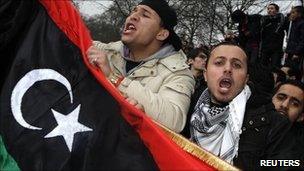Libya's oil wealth not trickling down
- Published

Around the world, Libya's pre-Gaddafi flag is being waved by protesters
As the world's 12th-largest oil exporter, Libya has the potential to unsettle the global economy if its violent anti-government protests disrupt supplies.
Since the lifting of UN and US sanctions ended the country's pariah status, foreign investors have flocked back in the past five years or so, including big oil firms such as BP and Exxon Mobil.
But BP, for one, is so concerned by the current turmoil that it is drawing up plans to pull out staff.
The company, which employs 40 foreign nationals in Libya, intends to evacuate families and non-essential staff over the next two days.
BP signed a deal with the Libya Investment Corporation in 2007 to explore two areas, one involving deep water drilling offshore in the Mediterranean Sirte basin and the other in the country's western desert.
A BP spokesman told the BBC the Sirte basin drilling was continuing, but that contracting staff in the Ghadames desert area had been pulled out and activity had been suspended there.
Although BP's operations have not yet led to the actual production of oil, the Sirte basin is responsible for most of Libya's oil output.
It contains about 80% of the country's proven oil reserves, which amount to 44 billion barrels, the largest in Africa.
Libya also benefits from having the kind of sweet, light crude oil that international oil traders like, with a low sulphur content and specific gravity that makes it ideal for processing into petrol and diesel fuel.
And since only a quarter of its vast and sparsely populated territory has been prospected, there is plenty to excite the industry.
Growth for some
More than half of Libya's GDP comes from the oil and natural gas sectors, which also account for more than 95% of exports, according to the World Bank.
Before the unrest began, the country's economy was enjoying a boom. The International Monetary Fund reckons Libya saw growth of 10.6% last year and had projected a growth rate of 6.2% for 2011.

But one of the big reasons for the protests is that this enormous wealth is not trickling down to the population at large.
According to some estimates, about one-third of Libyans live in poverty, although reliable statistics are hard to come by.
It is not unusual for people to have two jobs in order to augment their meagre salaries, although free public health care and other services help to bolster living standards.
Since Libya returned to the international fold after compensating families of the victims of the 1988 Lockerbie aircraft bombing, expectations have built up among ordinary people that the end of isolation should mean a material improvement in their lot.
So far, the wait has been in vain.
Demographic change
Interestingly, protesters in Benghazi are said to have pulled down the Libyan flag flying above the city's main court building and replaced it with the flag of the old monarchy, deposed in the September 1969 coup that brought Muammar Gaddafi to power.
Most of those taking part in the protests would have no memory of King Idris, the country's first and only monarch, since he was ousted more than 40 years ago and more than half the population is under 25.
During his reign, which began in 1951 with Libya's independence, the king maintained close ties with the UK and the US.
While he was on the throne, Washington gave the Libyan economy a major boost by stationing the biggest overseas US air force facility, the Wheelus air base, near the capital, Tripoli.
But Libya's usefulness as a US ally during the early Cold War years was not welcomed by the Libyan people.
In fact, they staged big demonstrations to denounce the king's pro-Western stance following the Arab armies' defeat in the Six Day War with Israel in 1967, in which Libya had played no part.
These protests paved the way for the 1969 military coup that saw Col Gaddafi installed as Libyan leader.
Now, under a new generation, the country appears to have come full circle, as a youthful population demands the prosperity that the colonel's erratic rule has failed to provide.